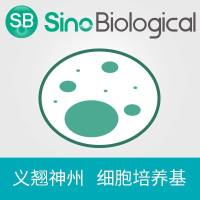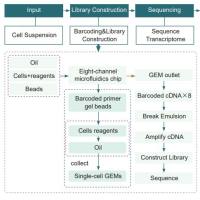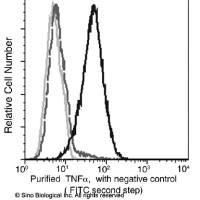Serum‐Free Generation of Multipotent Mesoderm (Kdr+) Progenitor Cells in Mouse Embryonic Stem Cells for Functional Genomics Screening
互联网
- Abstract
- Table of Contents
- Materials
- Literature Cited
Abstract
This unit describes a robust protocol for producing multipotent Kdr?expressing mesoderm progenitor cells in serum?free conditions, and for functional genomics screening using these cells. Kdr?positive cells are able to differentiate into a wide array of mesodermal derivatives, including vascular endothelial cells, cardiomyocytes, hematopoietic progenitors, and smooth muscle cells. The efficient generation of such progenitor cells is of particular interest because it permits subsequent steps in cardiovascular development to be analyzed in detail, including deciphering the mechanisms that direct differentiation. In addition, the oligonucleotide transfection protocol used to functionally screen siRNA and miRNA libraries is a powerful tool to reveal networks of genes, signaling proteins, and miRNAs that control the diversification of cardiovascular lineages from multipotent progenitors. Technical limitations, troubleshooting, and potential applications of these methods are discussed. Curr. Protoc. Stem Cell Biol. 23:1F.13.1?1F.13.13. © 2012 by John Wiley & Sons, Inc.
Keywords: mouse embryonic stem cells; mesendoderm; mesoderm; endoderm; siRNA; transfection; Kdr; Foxa2
Table of Contents
- Introduction
- Basic Protocol 1: Culture and Freezing of Mouse Embryonic Stem Cells
- Basic Protocol 2: Differentiation of Mouse Embryonic Stem Cells into Multipotent Mesoderm Progenitor (Kdr+) Cells
- Alternate Protocol 1: Differentiation of Mouse Embryonic Stem Cells for High‐Throughput Functional Screening of siRNA/miRNA Libraries
- Basic Protocol 3: Paraformaldehyde Fixation and Immunostaining of Differentiated mESCs
- Basic Protocol 4: High‐Throughput Imaging and Quantification of Kdr and Foxa2 Expression
- Reagents and Solutions
- Commentary
- Literature Cited
- Tables
Materials
Basic Protocol 1: Culture and Freezing of Mouse Embryonic Stem Cells
Materials
Basic Protocol 2: Differentiation of Mouse Embryonic Stem Cells into Multipotent Mesoderm Progenitor (Kdr+) Cells
Materials
Alternate Protocol 1: Differentiation of Mouse Embryonic Stem Cells for High‐Throughput Functional Screening of siRNA/miRNA Libraries
Basic Protocol 3: Paraformaldehyde Fixation and Immunostaining of Differentiated mESCs
Materials
Basic Protocol 4: High‐Throughput Imaging and Quantification of Kdr and Foxa2 Expression
Materials
|
Figures
Videos
Literature Cited
| Literature Cited | |
| Bushway, P.J. and Mercola, M. 2006. High‐throughput screening for modulators of stem cell differentiation. Methods Enzymol. 414:300‐316. | |
| Cheung, C., Bernardo, A.S., Trotter, M.W., Pedersen, R.A., and Sinha, S. 2012. Generation of human vascular smooth muscle subtypes provides insight into embryological origin‐dependent disease susceptibility. Nat. Biotechnol. 30:165‐173. | |
| Ema, M., Takahashi, S., and Rossant, J. 2006. Deletion of selection cassette but not cis‐acting elements in targeted Flk1‐lacZ allele reveals Flk1 expression in multipotent mesodermal progenitors. Blood 107:111‐117. | |
| Kane, N.M., Meloni, M., Spencer, H.L., Craig, M.A., Strehl, R., Milligan, G., Houslay, M.D., Mountford, J.C., Emanueli, C., and Baker, A.H. 2010. Derivation of endothelial cells from human embryonic stem cells by directed differentiation: Analysis of microRNA and angiogenesis in vitro and in vivo. Arterioscl. Thromb. Vasc. Biol. 30:1389‐1397. | |
| Kattman, S.J., Witty, A.D., Gagliardi, M., Dubois, N.C., Niapour, M., Hotta, A., Ellis, J., and Keller, G. 2011. Stage‐specific optimization of activin/nodal and BMP signaling promotes cardiac differentiation of mouse and human pluripotent stem cell lines. Cell Stem Cell 8:228‐240. | |
| Mercola, M., Colas, A., and Willems, E. 2012. iPSCs in cardiovascular drug discovery. Circ. Res. In press. | |
| Savitzky, A. and Golay, B. 1964. Smoothing and differentiation of data by simplified least squares procedures. Anal. Chem. 36:1627‐1639. | |
| Vazao, H., das Neves, R.P., Graos, M., and Ferreira, L. 2011. Towards the maturation and characterization of smooth muscle cells derived from human embryonic stem cells. PLoS One 6:e17771. |









